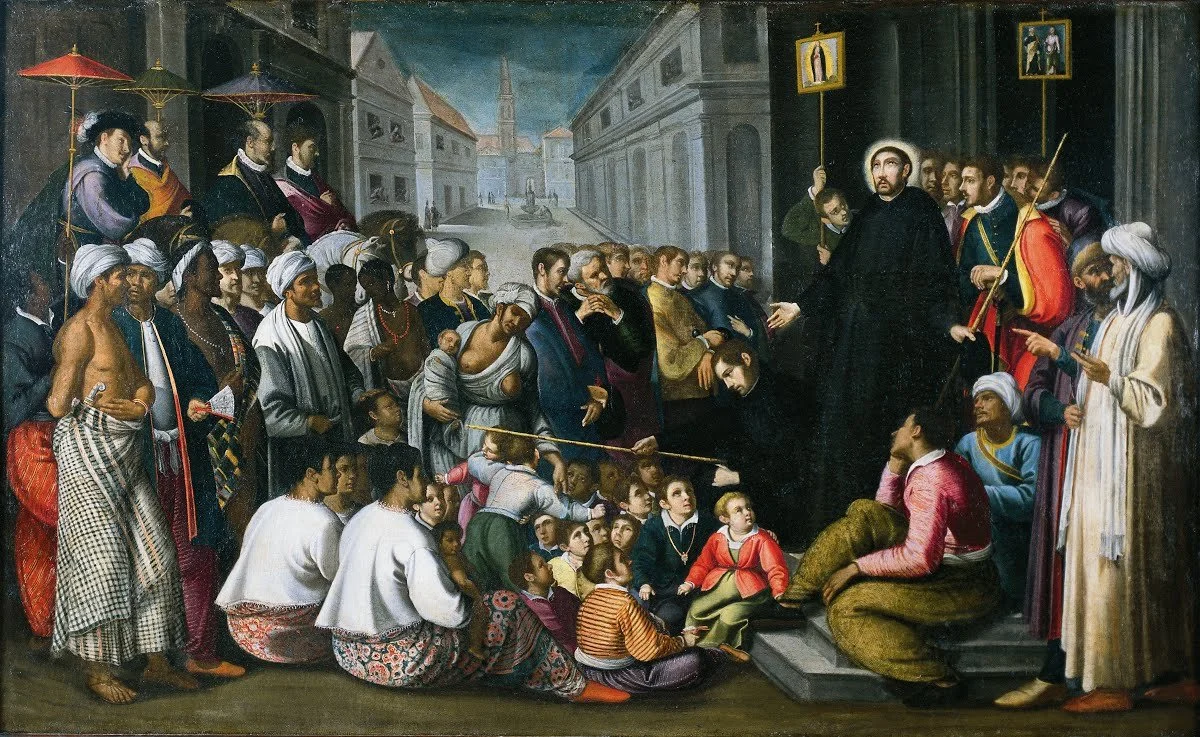Spot the figure in the lungi in the painting below
In the early seventeenth century, Portuguese painter André Reinoso created Saint Francis Xavier Preaching in Goa—one of twenty canvases narrating the life of the Jesuit missionary whose journeys popularized Christianity across Asia. Painted around 1610 (may be a little later), for the Jesuit Church of São Roque in Lisbon, the work reflects the fervent missionary spirit and global reach of early modern Catholicism.
Reinoso’s scene imagines a moment in Goa, then the heart of Portugal’s Indian Ocean empire. Saint Francis Xavier stands at the center, arm raised, addressing a crowd that includes Indian listeners in vivid dress, children gathered at his feet, and Portuguese soldiers and nobles on horseback. Though the artist never visited India, his rendering of costume and setting reveals a fascination with ethnographic detail—an attempt to visualize the “exotic” world of the East for European viewers.
In Lisbon, these paintings served both as devotional tools and as propaganda for Jesuit missionary triumphs abroad.
For me the most fascinating elements of this painting are of course the variety of textiles displayed. While Reinoso never visited India, Indian textiles were abundantly available in Lisbon at this time and I wonder if he may have sourced some of these textiles locally to use as samples in this painting. In any case, because I work with checked cotton textiles, I was excited to notice the lungi depicted here.
On the far right, closest to the viewer, stands a man in a lazy contrapposto posture, arm around waist gently resting on the top fold of his single wrap lungi.
The lungi—a simple, woven wrap of cotton—has been an essential garment in South India for centuries. Worn by men and women across Tamil Nadu, Kerala, and other parts of South India, it functions as both workwear and leisurewear, prized for its comfort in the tropical climate. Woven in local handloom centers in South India as well as in western India and Bengal, lungis are recognizable by their bold, yarn-dyed checks and stripes.
In the painting, the lungi is shown for what it is — the humble everyday wear of the working classes. It is easily identifiable and distinguishable not only as a textile but as a way to delineate the class structuring of the painting: the people to the left side of the Francis Xavier are Indians, to the right are Portuguese or Luso-Indian. The lungi-wearing man carries a nice dagger that is pushed into the waist of the lungi.
My second favorite element in the painting are the boisterous children in the middle not quite interested in the preaching and being disciplined by another missionary.
The details are so well-done in this painting and I have to remind myself that none of these paintings are documentary in its nature.
Curator John Guy talks about this painting briefly in a chapter about the very early globalization of the Indian textiles’ styles. He confirms that while not ethnographic, all these textiles you see people wearing in this painting are accurately portrayed. The book is available to read in full online.
Indeed, if you are familiar with the lungi, a black and white checked cotton lungi is something that is still worn in India today.
Though humble, the lungi’s history traces deep cultural and trade connections across the Indian Ocean. Its checked patterns and tubular form link it to a family of wrap garments—including the Burmese longyi and Malay sarong—that circulated through maritime exchange since early medieval times. By the eighteenth century, similar South Indian checked cottons were shipped worldwide as “Madras,” shaping fashion far beyond the subcontinent.
If you are curious about the use of Madras checks in the world, check out my collaborative digital history project
Connecting Threads: Fashioning Madras in the Caribbean.
In South India today, the lungi remains both a marker of local identity and a living textile tradition—adapted by powerloom and handloom weavers alike, bridging the ordinary and the global in a single piece of cloth.
Recommended Reading: Andrews, Jean. 2023. The Canonization of St Francis Xavier in Spanish Habsburg Lands: A Poetry Challenge in Madrid, Sacristy Paintings by André Reinoso in Lisbon and an Altarpiece by Pieter Pawel Rubens in Antwerp. Religions 14, no. 12: 1505.



